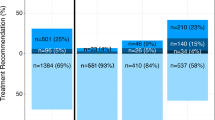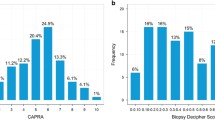Abstract
Objective
To externally validate a Genomic Classifier (GC) based risk-stratification nomogram identifying candidates who would benefit from adjuvant radiation (aRT) therapy after radical prostatectomy (RP).
Methods
We identified 350 patients who underwent RP, between 2013 and 2018, and had adverse pathological features (positive margin, and/or pT3a or higher) on final pathology. Genomic profile was available for all these men. The clinical recurrence-free survival was estimated using the Kaplan–Meier method. The external validity of the nomogram was tested using the concordance index (c-index), calibration plot, and decision curve analysis.
Results
The median follow-up of the cohort was 26.5 months. Overall, 14% of the patients received aRT. During the follow-up period, 3.4% of the patients developed metastasis. Overall 3-year metastasis-free survival was 95% (95% CI 0.92–0.98). The c-index of the nomogram was 0.84. The calibration of the model was favorable. Decision-curve analysis showed a positive net benefit for probabilities ranging between 0.01 and 0.09, with the highest difference at threshold probability around 0.05. At that threshold, the net benefit is 0.06 for the model and 0 for treating all the patients.
Conclusion
Our report is the first to confirm the validity of this genomic-based risk-stratification tool in identifying men who might benefit from aRT after RP. As such, it can be a useful instrument to be incorporated in shared decision making on whether administration of aRT will lead to a clinically meaningful benefit. Such a model can also be useful for patients’ classification in future clinical trials.



Similar content being viewed by others
Availability of data and material
Upon reviewer request.
References
Hager B, Kraywinkel K, Keck B, Katalinic A, Meyer M, Zeissig SR, Scheufele R, Wirth MP, Huber J (2017) Increasing use of radical prostatectomy for locally advanced prostate cancer in the USA and Germany: a comparative population-based study. Prostate Cancer Prostatic Dis 20(1):61–66
- Briganti A, Karnes RJ, Gandaglia G, Spahn M, Gontero P, Tosco L, Kneitz B, Chun FK, Zaffuto E, Sun M, Graefen M. Natural history of surgically treated high-risk prostate cancer. InUrologic Oncology: Seminars and Original Investigations 2015. (Vol. 33, No. 4, pp. 163-e7). Elsevier.
Freedland SJ, Humphreys EB, Mangold LA, Eisenberger M, Dorey FJ, Walsh PC, Partin AW (2005) Risk of prostate cancer-specific mortality following biochemical recurrence after radical prostatectomy. JAMA 294(4):433–439
Thompson IM Jr, Tangen CM, Paradelo J, Lucia MS, Miller G, Troyer D, Messing E, Forman J, Chin J, Swanson G, Canby-Hagino E, Crawford ED (2006) Adjuvant radiotherapy for pathologically advanced prostate cancer: a randomized clinical trial. JAMA 296(19):2329–2335
-Bolla M, van Poppel H, Tombal B, Vekemans K, Da Pozzo L, de Reijke TM, Verbaeys A, Bosset JF, van Velthoven R, Colombel M, van de Beek C, Verhagen P, van den Bergh A, Sternberg C, Gasser T, van Tienhoven G, Scalliet P, Haustermans K, Collette L; European Organisation for Research and Treatment of Cancer, Radiation Oncology and Genito-Urinary Groups. Postoperative radiotherapy after radical prostatectomy for high-risk prostate cancer: long-term results of a randomised controlled trial (EORTC trial 22911). Lancet. 2012 Dec 8;380(9858):2018–27.
Wiegel T, Bottke D, Steiner U, Siegmann A, Golz R, Störkel S, Willich N, Semjonow A, Souchon R, Stöckle M, Rübe C, Weissbach L, Althaus P, Rebmann U, Kälble T, Feldmann HJ, Wirth M, Hinke A, Hinkelbein W, Miller K (2009) Phase III postoperative adjuvant radiotherapy after radical prostatectomy compared with radical prostatectomy alone in pT3 prostate cancer with postoperative undetectable prostate-specific antigen: ARO 96–02/AUO AP 09/95. J Clin Oncol 27(18):2924–2930
-Heidenreich A, Bastian PJ, Bellmunt J, Bolla M, Joniau S, van der Kwast T, Mason M, Matveev V, Wiegel T, Zattoni F, Mottet N; European Association of Urology. EAU guidelines on prostate cancer. part 1: screening, diagnosis, and local treatment with curative intent-update 2013. Eur Urol. 2014;65(1):124–37.
Thompson IM, Valicenti RK, Albertsen P, Davis BJ, Goldenberg SL, Hahn C, Klein E, Michalski J, Roach M, Sartor O, Wolf JS Jr, Faraday MM (2013) Adjuvant and salvage radiotherapy after prostatectomy: AUA/ASTRO Guideline. J Urol 190(2):441–449
Ross AE, Feng FY, Ghadessi M, Erho N, Crisan A, Buerki C, Sundi D, Mitra AP, Vergara IA, Thompson DJ, Triche TJ (2014) A genomic classifier predicting metastatic disease progression in men with biochemical recurrence after prostatectomy. Prostate cancer and prostatic diseases 17(1):64
Dalela D, Santiago-Jiménez M, Yousefi K, Karnes RJ, Ross AE, Den RB, Freedland SJ, Schaeffer EM, Dicker AP, Menon M, Briganti A, Davicioni E, Abdollah F (2017) Genomic Classifier Augments the Role of Pathological Features in Identifying Optimal Candidates for Adjuvant Radiation Therapy in Patients With Prostate Cancer: Development and Internal Validation of a Multivariable Prognostic Model. J Clin Oncol 35(18):1982–1990
Kattan MW (2011) Factors affecting the accuracy of prediction models limit the comparison of rival prediction models when applied to separate data sets. Eur Urol 59:566–567
Fleshner K, Carlsson SV, Roobol MJ (2017) The effect of the USPSTF PSA screening recommendation on prostate cancer incidence patterns in the USA. Nat Rev Urol 14(1):26–37. https://doi.org/10.1038/nrurol.2016.251
-Byrd DR, Carducci MA, Compton CC, Fritz AG, Greene FL. AJCC cancer staging manual. Edge SB, editor. New York: Springer; 2010.
Klein EA, Haddad Z, Yousefi K, Lam LL, Wang Q, Choeurng V, Palmer-Aronsten B, Buerki C, Davicioni E, Li J, Kattan MW (2016) Decipher genomic classifier measured on prostate biopsy predicts metastasis risk. Urology 1(90):148–152
-spratt DE, Yousefi K, Deheshi S, Ross AE, Den RB, Schaeffer EM, Trock BJ,Zhang J, Glass AG, Dicker AP, Abdollah F, Zhao SG, Lam LLC, du Plessis M,Choeurng V, Haddad Z, Buerki C, Davicioni E, Weinmann S, Freedland SJ, Klein EA, Karnes RJ, Feng FY. Individual Patient-Level Meta-Analysis of the Performance of the Decipher Genomic Classifier in High-Risk Men After Prostatectomy to Predict Development of Metastatic Disease. J Clin Oncol. 2017;35(18):1991–1998.
Gerds TA, Kattan MW, Schumacher M, Yu C (2013) Estimating a time-dependent concordance index for survival prediction models with covariate dependent censoring. Stat Med 32(13):2173–2184
Vickers AJ, Elkin EB (2006) Decision curve analysis: a novel method for evaluating prediction models. Med Decis Making 26(6):565–574
Sineshaw HM, Gray PJ, Efstathiou JA, Jemal A (2015) Declining Use of Radiotherapy for Adverse Features After Radical Prostatectomy: Results From the National Cancer Data Base. Eur Urol 68(5):768–774
-C L Vale, M Brihoum, S Chabaud, A Cook, D Fisher, S Forcat, C Fraser-Browne, A Herschtal, A Kneebone, S Nénan, C Parker, M K B Parmar, M Pearse, P Richaud, E Rogozińska, P Sargos, M R Sydes, J F Tierney, LBA48_PR .Adjuvant or salvage radiotherapy for the treatment of localised prostate cancer? A prospectively planned aggregate data meta-analysis, Annals of Oncology. 30 (Supplement_5), 2019, mdz394.041
Abdollah F, Suardi N, Cozzarini C, Gallina A, Capitanio U, Bianchi M, Sun M, Fossati N, Passoni NM, Fiorino C, Di Muzio N, Karakiewicz PI, Rigatti P, Montorsi F, Briganti A (2013) Selecting the optimal candidate for adjuvant radiotherapy after radical prostatectomy for prostate cancer: a long-term survival analysis. Eur Urol 63(6):998–1008
Acknowledgments
Nothing to Acknowledge
Funding
None.
Author information
Authors and Affiliations
Contributions
DIL: concept, manuscript writing. MS: concept, data collection, manuscript writing. DD: manuscript editing. JK: data analysis. PL: manuscript editing. NV: manuscript editing. FA: result interpretation, manuscript writing and editing.
Corresponding author
Ethics declarations
Conflict of interest
Firas Abdollah is a consultant for GenomeDx Biosciences.
Ethical approval
Approved by the IRB of the University of Pennsylvania.
Additional information
Publisher's Note
Springer Nature remains neutral with regard to jurisdictional claims in published maps and institutional affiliations.
Rights and permissions
About this article
Cite this article
Lee, D.I., Shahait, M., Dalela, D. et al. External validation of genomic classifier-based risk-stratification tool to identify candidates for adjuvant radiation therapy in patients with prostate cancer. World J Urol 39, 3217–3222 (2021). https://doi.org/10.1007/s00345-020-03540-1
Received:
Accepted:
Published:
Issue Date:
DOI: https://doi.org/10.1007/s00345-020-03540-1




